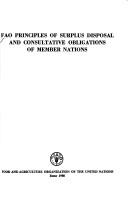| Listing 1 - 10 of 2152 | << page >> |
Sort by
|
Digital
Abstract | Keywords | Export | Availability | Bookmark
 Loading...
Loading...Choose an application
- Reference Manager
- EndNote
- RefWorks (Direct export to RefWorks)
Book
ISBN: 0631171126 Year: 1990 Publisher: Oxford Blackwell
Abstract | Keywords | Export | Availability | Bookmark
 Loading...
Loading...Choose an application
- Reference Manager
- EndNote
- RefWorks (Direct export to RefWorks)
Commercial policy. --- Primary commodities --- Primary commodities. --- Prices.

ISBN: 2747508803 Year: 2001 Publisher: Paris : L'Harmattan,
Abstract | Keywords | Export | Availability | Bookmark
 Loading...
Loading...Choose an application
- Reference Manager
- EndNote
- RefWorks (Direct export to RefWorks)
Book
Year: 1977 Volume: 42-43 Publisher: [Paris] : Organisation de coopération et de développement économiques,
Abstract | Keywords | Export | Availability | Bookmark
 Loading...
Loading...Choose an application
- Reference Manager
- EndNote
- RefWorks (Direct export to RefWorks)
Primary commodities --- Abstracts --- Bibliography
Book
Year: 2009 Publisher: Cambridge, Massachusetts : National Bureau of Economic Research,
Abstract | Keywords | Export | Availability | Bookmark
 Loading...
Loading...Choose an application
- Reference Manager
- EndNote
- RefWorks (Direct export to RefWorks)
This paper uses a dynamic optimization model to estimate the welfare gains of hedging against commodity price risk for commodity-exporting countries. We show that the introduction of hedging instruments such as futures and options enhances domestic welfare through two channels. First, by reducing export income volatility and allowing for a smoother consumption path. Second, by reducing the country's need to hold foreign assets as precautionary savings (or by improving the country's ability to borrow against future export income). Under plausibly calibrated parameters, the second channel may lead to much larger welfare gains, amounting to several percentage points of annual consumption.
Book
ISBN: 1283895838 1606500759 Year: 2012 Publisher: [New York, N.Y.] (222 East 46th Street, New York, NY 10017) : Momentum Press,
Abstract | Keywords | Export | Availability | Bookmark
 Loading...
Loading...Choose an application
- Reference Manager
- EndNote
- RefWorks (Direct export to RefWorks)
A basic understanding and knowledge of materials is rudimentary to both the accomplished tradesman as well as the draftsman. The subject of materials, however, is not generally taught in a vocational setting. It will be shown that a length of brass is not just a length of brass, but an example of a specific alloy that determines whether it can be more easily machined, or rather formed. Yet, for each of the basic materials listed, entire texts have been written and published. It is not, therefore, my intention to delve deeply into such matters as failure analysis or to dissect various exotic composites. Rather, this is a concise text that will introduce the most common materials along with their properties and uses, which both the student and journeyman will find useful. Even as much, there are almost 500 alloys of wrought aluminum registered to the Aluminum Association of the United States, though I have selected only seven to list in this text. No assumption has been made concerning the previous education of the reader, and everything has been written from the ground up, without jargon.
Book
Year: 2011 Publisher: [Gaithersburg, Md.] : U.S. Dept. of Commerce, National Institute of Standards and Technology,
Abstract | Keywords | Export | Availability | Bookmark
 Loading...
Loading...Choose an application
- Reference Manager
- EndNote
- RefWorks (Direct export to RefWorks)
Book
Year: 2017 Publisher: Reston, Virginia : U.S. Department of the Interior, U.S. Geological Survey,
Abstract | Keywords | Export | Availability | Bookmark
 Loading...
Loading...Choose an application
- Reference Manager
- EndNote
- RefWorks (Direct export to RefWorks)

Abstract | Keywords | Export | Availability | Bookmark
 Loading...
Loading...Choose an application
- Reference Manager
- EndNote
- RefWorks (Direct export to RefWorks)
Book
Year: 2004 Publisher: Gaithersburg, MD : Washington, DC : U.S. Dept. of Commerce, Technology Administration, National Institute of Standards and Technology ; For sale by the Supt. of Docs., U.S. G.P.O.,
Abstract | Keywords | Export | Availability | Bookmark
 Loading...
Loading...Choose an application
- Reference Manager
- EndNote
- RefWorks (Direct export to RefWorks)
This handbook has been prepared as a procedural guide for the compliance testing of net contents statements on packaged goods. Compliance testing of packaged goods is the determination of the conformance results of the packaging, distribution, and retailing process (the packages) to specific legal requirements for net content declarations. This handbook has been developed primarily for the use of government officials; however, it should also be useful to commercial and industrial establishments in the areas of packaging, distribution, and sale of commodities. In conducting compliance testing, the conversion of quantity values from one measuring system to another (e.g., from the metric system to the avoirdupois system) should be handled with careful regard to the implied correspondence between accuracy of the data and the number of digits displayed. In all conversion, the number of significant digits retained should ensure that accuracy is neither sacrificed nor exaggerated. For this edition of Handbook 133, all dimensions for test procedures, devices, or environments have been rounded to two significant digits (e.g., 2.5 cm to 1.0 in) or to a precision level applicable to the test equipment (e.g., 200 kPa for 25 psi and 35 MPs for 5000 psi).
| Listing 1 - 10 of 2152 | << page >> |
Sort by
|

 Search
Search Feedback
Feedback About UniCat
About UniCat  Help
Help News
News